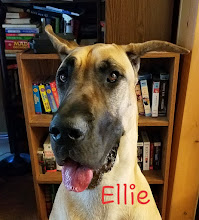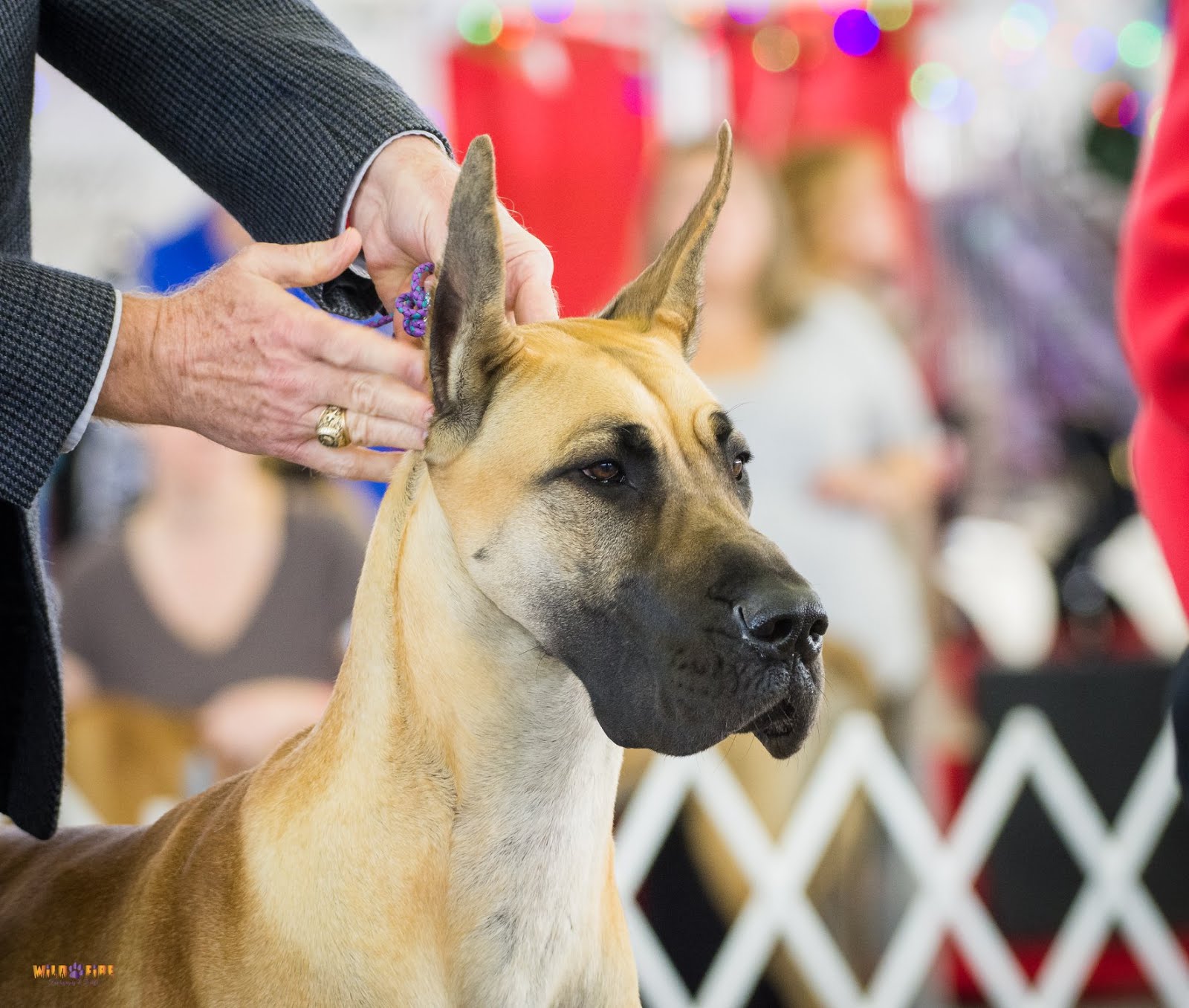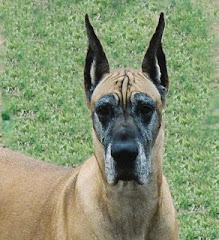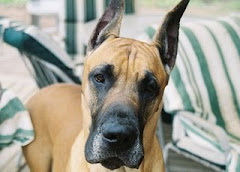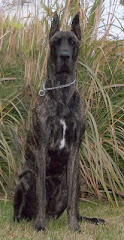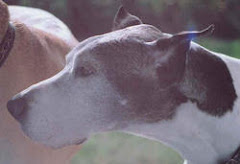Overview:
Since the dog will be heeling on your left, in most cases the handler should follow a path that will keep the Rally signs on his or her right side. Makes sense when you think of it: it makes the Rally signs easier for the handler to see, and you don't have to worry about the dog tripping over a sign. The signs used on a particular course will be numbered in the order that they should be performed.
I've added notes about the training origin of the Rally exercises, since Rally is based on training "doodles" that have been used for generations to help teach dogs better heeling and to improve other obedience exercises - as well as to make training interesting! You don't want to drill the same thing over and over or you'll both get bored! I think it helps to understand the exercises, if you know something about what they are supposed to DO.
-----------------------
#1 START
All Rally courses will have a Start sign to show the handler where the beginning of the course is. The dog does not have to be sitting, but should be in Heel position. The handler and dog should wait by that sign until the judge says "Forward". Rally courses are timed, and the time starts when the judge says "Forward", not necessarily when the team passes the Start sign. There is no minimum time in Rally, nor are there time penalties. The time is ONLY used to break ties for placements in the class.
The Start sign looks like this:

Let me take a break here before we get into any more signs and talk about the Reference numbers.
See the "N, A, X-#1" in the upper right corner? That sort of thing will be in the corner of all Rally signs,
The "N" means that this sign may be used on a Novice course. The "A" means this sign may be used on an Advanced course. The "X" means this sign may be used on an Excellent level course.
In other words, when you see "N, A, X" that is a sign that may be used at all levels.
The "#1" is the Reference number for the Start sign. That means this is the first sign listed among the AKC Rally signs. The reference number makes it more convenient for course designers to find the sign they want to use in the stack - there are a lot of signs! It can also be useful for competitors if you want to look up a sign to be sure how to perform that exercise. The signs that are allowed in the different classes are grouped together. Signs that may be used in Novice courses will all have Reference numbers less than 100. Signs that may be used in Advanced and Excellent, but NOT Novice, will have Reference numbers between 100 and 199. Signs that may ONLY be used on Excellent courses will have Reference numbers in the 200s.
For these posts, I've grouped the Rally signs based on similarities: either in the type of exercise or in how they look, so you can start to learn to tell the differences. So we aren't going to go through them all in strictly numerical order.
----------------------
#2 FINISH

The Finish sign indicates the end of the course. The time will stop when the team passes by the Finish sign.
----------------------
Before we continue, a word about how Rally is scored in AKC. A perfect score is 100, and a 70 or better is required in order to qualify. One qualifying score = one "leg" toward a Rally title. Novice, Advanced, and Excellent each require 3 "legs" to earn the title. You must complete the Novice title before you can compete in Advanced, and you must finish the Advanced title before you compete in Excellent. After Excellent, there is an additional title called the Rally Advanced Excellent title. This requires the dog and handler to qualify in BOTH the Advanced AND the Excellent class, in one trial, to equal one "leg". And for the RAE you have to get 10 legs! But for all of these titles, class placements are not necessary. Theoretically, every dog in every class could qualify - and in fact, the qualifying rate in Rally is usually pretty high. Rally is not super easy, but it is very doable for most dog and handler teams. Which makes it less stressful, and a GREAT event for handlers who are new to dog shows!
Anyway, back to the scoring. For each exercise sign, there are certain essential elements, and other elements that are desired but not essential. If the dog and handler fail to perform an essential element, then they are deducted 10 points for an Incorrect Performance (IP). Otherwise, they are deducted anything from 1 to 10 points for other errors. "Do -Overs" (called a Re-try) are allowed in Rally, you may try any exercise again if you didn't do it right the first time. Just one re-try per exercise is allowed, and you get a 3 point deduction for the re-try. So it's not something you want to do unless you've made a major mistake. You will want to read the Rules and Regulations for details on scoring, but as I talk about the signs I'll point out the essential elements. They will be written in Bold. You can find the Regs here: http://www.akc.org/rules/index.cfm
*One of the biggest causes of lost points in Novice, is a tight leash. The dog is on leash for the entire course in Novice, but the leash must be LOOSE. Every time the leash gets tight, you'll get a deduction. In Advanced and Excellent, the dog is off leash the whole time. In Rally, the handler can talk to the dog and use hand signals pretty much as often as desired.
---------------------------
First, we'll talk about some of the basic change of direction signs. These are self explanatory, but there are a few things to keep in mind:
- If the sign is for a change in direction, it will be in front of you - i.e. in your path. Instead of on your right like most signs.
- You still want to do the change of direction fairly close to the sign - don't cut corners or you can get a penalty. You want to keep your turns smooth, so allow just enough room or make the turn comfortably.
- Remember that as you make turns, the dog should be moving with you and staying in Heel position. This means that when you are turning to the Right, the dog will have to speed up to stay with you. When you are turning Left, the dog will have to slow down.
#5 Right Turn

5. Right Turn: The handler and dog make a smooth 90 degree turn to the Right without stopping. This sign may be used more than once in a Rally course.
----------------------
#6 Left Turn

6. Left Turn: the team makes a smooth 90 degree turn to the Left without stopping. This sign also may be used more than once.
----------------------
#7 About Turn Right

7. About Turn–Right: While heeling, the team makes a 180° about turn to the handler’s right. This sign may be used more than once.
*Note - this should be a fairly tight turn but does NOT have to be a pivot, or an in-place turn. It's fine to walk forward through the turn.
Training origin: The Right Turn, Left Turn, and About Turn are traditional elements of the Obedience heeling pattern. They test the dog's ability to stay in Heel position by the handler's left leg: when turning to the left, the dog must slow down a bit or she will be forging ahead... when turning Right or doing a traditional About Turn, the dog must speed up stay in position.
----------------------
#8 About "U" Turn

8. About “U” Turn: While heeling, the team makes a 180° turn to the handler’s left. This sign also may be used more than once.
*Note: again, this should be a fairly tight turn but does not have to be in-place: the team should keep moving forward.
Training origin: the "U" turn is a frequently used training exercise, once the dog has started to understand that he must slow down on Left turns, to REALLY get him to slow down, even step backward, in order to stay in Heel position.
----------------------
#9 270 Right Turn

9. *270° Right Turn: While heeling, the team makes a 270° turn to the handler’s right. 270° turns are performed as a tight circle, but not around the exercise sign.
This sign may be used more than once.
NOTE: The yellow arrow shows you the path you will take as you make this turn. Can you see that, even though you are turning to your right to make this turn, you will end up going to the left? From a course building standpoint, this sign works the same as a left turn.
----------------------
#10 270 Left Turn

10. 270° Left Turn: While heeling, the team makes a 270° turn to the handler’s left. 270° turns are performed as a tight circle, but not around the exercise sign. This sign may be used more than once.
NOTE: as with #9, this sign will have you turning in one direction, but ultimately changing your direction to go the other way. In this case, you turn to the left but it works like a Right turn.
The thing that helps me keep it straight is to think of following the yellow arrow's path. As long as you know which way you should be going when you've completed this turn, it will help keep you from getting lost.
The 270 degree turns are MAJOR cause of handlers getting lost on Rally courses! If you have trouble with this, go to http://www.akc.org/dog_shows_trials/rally/index.cfm and at the bottom of the page you can see a link to print a set of Rally signs. You just need to print the ones you have trouble with, or want to practice. Print a full-sized copy and put it up somewhere in your house where you'll see it several times a day. Practice the footwork without your dog. In a day or two you'll know that sign by heart! This is also a very effective strategy for signs that are easily confused with each other.
Training origin: Again, these are exercises to help the dog learn to speed up on Right turns, and slow down on Left turns in order to stay in Heel position.
------------------------------
Some basic Stationary exercises: After the description for some Rally signs, you'll see the notation
(Stationary Exercise). The number of Stationary exercises is limited in Rally, because the courses are supposed to have some flow and that won't happen if you are constantly stopping.
In Novice level - and all the signs we're talking about now can be used on Novice courses - the total number of exercises on a course should be between 10 to 15 signs. At least 3 but no more than 5 of those should be Stationary exercises.
#3 HALT - Sit

3. HALT–Sit: While heeling, the handler halts and the dog sits in heel position. The team then moves forward, with the dog in heel position.
(Stationary exercise)
Note: as with all Rally exercises, the handler may talk to the dog and/or give hand signals. In other words, as you walk up to this sign and prepare to halt, you may tell your dog to "Sit" and use a hand signal if you want. As soon as your dog is sitting, you can go on.
Training origin: this is the basic Halt, with the dog sitting in Heel position, used throughout traditional obedience.
----------------------
Remember the bit about "essential elements"? That's the phrase in Bold. That means that if you don't do that part, you won't get credit for any other part of the exercise.
----------------------
#4 HALT - Sit - Down

After the dog sits, he shouldn't stand up before lying down in this exercise. As soon as the dog is all the way down, the handler and dog may heel forward to the next sign. The dog should not sit before he moves forward.
Training origin: this exercise will never be used in traditional obedience, but is often used in training just to change things up, and keep it interesting.
----------------------
NOTE: See the big red "Halt" stop signs in the upper left corner of these signs? That tells you that this exercise starts with the handler standing still and the dog sitting in Heel position. In the case of sign #3, that's the whole exercise. But for many Rally signs, that sit in Heel position is just the starting point. So to save space on the signs, later on you won't see the word "Sit" on the sign in reference to that first Halt and Sit. But if you see that big red stop sign, you'll know that the first thing you do when you get to that sign is halt, and have your dog sit.
----------------------
Here are two signs that involve turns, but are NOT changes of direction:
----------------------
#11 360 degree Right Turn:


Each of these exercises are performed as a tight circle, with the dog staying by the Handler's left side in Heel position. The circle is to be performed near the sign, but NOT around the sign.
Be sure to notice which way the circle turns! If you do the circle in the wrong direction, that is 10 points off for an Incorrect Performance!
Training origin: circles have long been used to start to teach the dog the Figure 8, which is a traditional exercise. Like the turns - but more so! - when making a circle the dog must speed up when going to the Right, and slow down when going to the Left.
----------------------
Finally, there are signs that indicate a change of pace, or speed. Normally, heeling should be done a a brisk walk. It doesn't matter much what size your dog is, since pretty much any dog can easily move faster than a walking human. I tell my students that your Normal heeling pace should be the kind of walk you do when you are wanting to get somewhere, but aren't in a terrible hurry. It should be a comfortable, brisk pace.
----------------------
#17 Slow Pace, and #18 Fast Pace.


Either of these must be followed by #19 Normal Pace, except that the Slow may be the last sign on the course.

The change of speed must be noticeable, and should happen near the sign (usually slightly in front and to the left of the sign) just like any of the other exercises. I tell my students that the Slow Pace is a stroll, like if you were window shopping. For the Fast Pace, the handler should break into a jog.
Training origin: changes of pace are traditional obedience exercises: the dog should learn to stay in Heel position as the handler moves freely about, turning, slowing down, speeding up, stopping.
That is enough for this post! With these basic signs, you could design yourself a simple, practice Rally course. Try it! Print out a few signs, and you can even just lay them on the ground to start with. Try making a little course in your back yard. If you want to read more about the AKC Rally signs here are more resources:
The official AKC Obedience and Rally rules, with Rally signs and descriptions
Color images of the signs with annotations regarding their definitions.
One final tip: as we go through all the signs, you will find at least some that are confusing for you. And you'll find signs that are hard to tell apart. The best tip I've ever had for dealing with these signs is to print out a full page copy of the sign (black & white is fine) and post it somewhere in your house where you will see it several times a day. In a hallway, on your refrigerator, etc. Every time you walk up to that sign, stop and perform the action as if you had your dog with you. You do NOT need to fetch your dog every time! In fact, it's best if you get the exercise firmly in your mind, and get comfortable with any footwork, BEFORE you try it with your dog. After a few days you will know it by heart.

